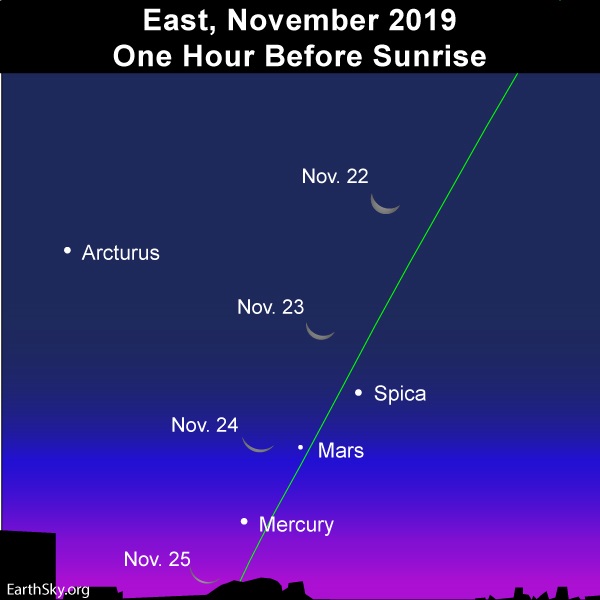
In the eastern morning sky around November 8, 9 and 10, 2019 – as the predawn darkness gives way to dawn – watch for the red planet Mars to pair up with blue-white Spica, brightest star in the constellation Virgo the Maiden. Their conjunction date – when Mars passes three degrees north of Spica on our sky’s dome – is November 8.
These two worlds will remain close together all week long, and should rather easily fit into a single binocular field.
Spica – a 1st-magnitude star – shines about twice as brightly as Mars does right now. So, in the early morning, you might see Spica – but not Mars – with the eye alone. If that’s the case, aim binoculars at Spica to view nearby Mars and Spica adorning the same binocular field together. Note the beautiful contrast of color between blue-white Spica and ruddy Mars.
The Northern Hemisphere has the advantage for watching the early morning Mars/Spica spectacle. That’s because Mars and Spica rise earlier before sunrise at more northerly latitudes, and closer to sunrise at more southerly latitudes. Here are the approximate rising times for Mars at various latitudes (presuming an absolutely level horizon) for the next several days:
35 degrees north latitude
Mars rises 1 3/4 hours before sunriseEquator (0 degrees latitude)
Mars rises 1 1/2 hours before sunrise35 degrees south latitude
Mars rises 1 hour before sunriseWant more specific rising times for your sky? Click here for an almanac.
The good news is that both Mars and Spica rise earlier in the morning sky with each successive day. But Spica climbs away from the sunrise at a greater clip than Mars does. So it won’t be too much longer before Mars falls beneath Spica in the November 2019 morning sky. And by the time the moon reaches this part of the sky on the mornings of November 23 and 24, 2019, Mars will be found roughly midway between Spica and the planet Mercury on the sky’s dome, as shown on the sky chart below.
EarthSky 2020 lunar calendars are available! They make great gifts. Order now. Going fast!

If you’re an early bird, waking up before the sun, then use the moon, and the star Spica to help you envision the ecliptic with the mind’s eye, and to find Mars and Mercury. Read more.
Mercury is nominally an evening “star” right now. Yet this world, named in honor of the fleet-footed messenger god, will transition from the evening to morning sky on November 11, 2019. Roughly a week thereafter, look for Mercury to take the stage with Mars and Spica in the morning sky.
Bottom line: These next several days – November 8, 9 and 10, 2019 – watch for the close pairing of the red planet Mars and the blue-white star Spica in the early morning sky.
from EarthSky https://ift.tt/2PXq1Sa

In the eastern morning sky around November 8, 9 and 10, 2019 – as the predawn darkness gives way to dawn – watch for the red planet Mars to pair up with blue-white Spica, brightest star in the constellation Virgo the Maiden. Their conjunction date – when Mars passes three degrees north of Spica on our sky’s dome – is November 8.
These two worlds will remain close together all week long, and should rather easily fit into a single binocular field.
Spica – a 1st-magnitude star – shines about twice as brightly as Mars does right now. So, in the early morning, you might see Spica – but not Mars – with the eye alone. If that’s the case, aim binoculars at Spica to view nearby Mars and Spica adorning the same binocular field together. Note the beautiful contrast of color between blue-white Spica and ruddy Mars.
The Northern Hemisphere has the advantage for watching the early morning Mars/Spica spectacle. That’s because Mars and Spica rise earlier before sunrise at more northerly latitudes, and closer to sunrise at more southerly latitudes. Here are the approximate rising times for Mars at various latitudes (presuming an absolutely level horizon) for the next several days:
35 degrees north latitude
Mars rises 1 3/4 hours before sunriseEquator (0 degrees latitude)
Mars rises 1 1/2 hours before sunrise35 degrees south latitude
Mars rises 1 hour before sunriseWant more specific rising times for your sky? Click here for an almanac.
The good news is that both Mars and Spica rise earlier in the morning sky with each successive day. But Spica climbs away from the sunrise at a greater clip than Mars does. So it won’t be too much longer before Mars falls beneath Spica in the November 2019 morning sky. And by the time the moon reaches this part of the sky on the mornings of November 23 and 24, 2019, Mars will be found roughly midway between Spica and the planet Mercury on the sky’s dome, as shown on the sky chart below.
EarthSky 2020 lunar calendars are available! They make great gifts. Order now. Going fast!

If you’re an early bird, waking up before the sun, then use the moon, and the star Spica to help you envision the ecliptic with the mind’s eye, and to find Mars and Mercury. Read more.
Mercury is nominally an evening “star” right now. Yet this world, named in honor of the fleet-footed messenger god, will transition from the evening to morning sky on November 11, 2019. Roughly a week thereafter, look for Mercury to take the stage with Mars and Spica in the morning sky.
Bottom line: These next several days – November 8, 9 and 10, 2019 – watch for the close pairing of the red planet Mars and the blue-white star Spica in the early morning sky.
from EarthSky https://ift.tt/2PXq1Sa

Aucun commentaire:
Enregistrer un commentaire